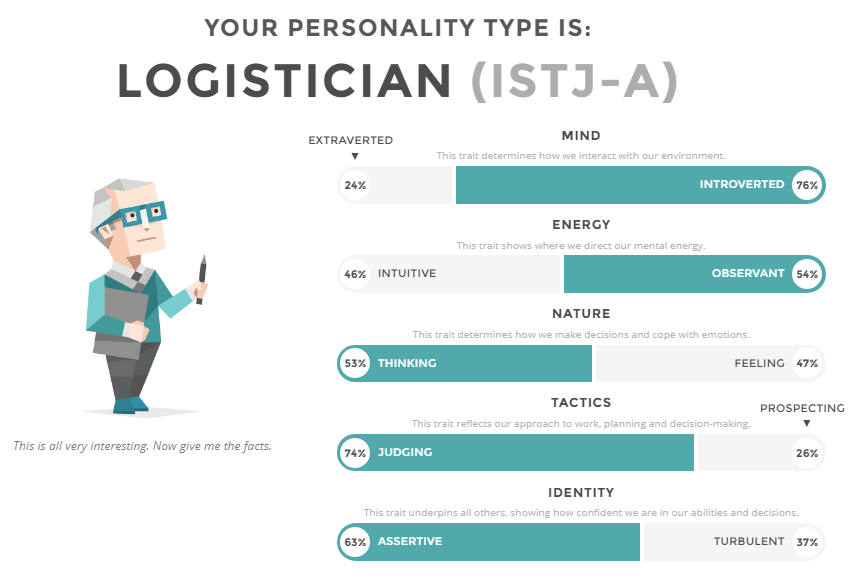Myers Briggs

I got a comment from one my readers (which is like 50% of my audience) asking if I’ve done more tests since Love Languages. As a matter of fact, I did recently take another self survey. This week, I continue my self exploration with the Myers Briggs personality test. This update is longer than usual as I take a deeper dive into my results and whether or not I agree with it and why.
What I tried:
Free Personality Test | 16Personalities
Jung Typology Test | Humanmetrics
The Myers-Briggs personality test is one of the most well known tests of its kind. According to the 16Personalities homepage, over 130 million users have taken the test. It’s most famous for spitting out a four letter indicator that describes your personality type. The Myers-Briggs Type Indicator is based off of Carl Jung’s research and basically states that our personality falls between a pair of opposite traits, such as introversion and extroversion. Each letter in the indicator describes a personality pair. The four pairs describe how we interact with stimuli, process information, and make decisions. I briefly describe the types below but more information can be found on this website.
Introverted/Extroverted: This pair deals with more than just how you handle social situations, it also describes how you get your energy. Introverts remind me of librarians, they prefer quieter situations and like to live inside their heads. Extroverts are more like a stereotypical frat bro who loves being around others and enjoy engaging in a wide range of activities.
Intuition/Sensing: This grouping describe how you process information. Intuitive types bring to mind a scientist, they like to tease out the pattern behind information. People with this personality type also tend to look for the meaning behind what is seen and heard. While Sensing types are like lawyers, they like to stick to the facts and what actually happened. They deal with what’s real and in front of you, focusing on the actual experience.
Thinking/Feeling: These two details how you prefer to make decisions. The thinking types remind of engineers, they like to use analytical processes and logically go through the problem. It’s all about the most efficient or effective way to do things. The feeling types are more like Buddhist monks, they rely on their compassion and feelings towards others when making decisions. They also value harmony and sparing people’s feelings over the hard truth.
Judging/Perception: This combination breaks down how you like to structure your lifestyle. Judging types like to have things planned out. They make lists and tend to focus their attention on achieving their goals. Perceiving types like to approach things with an open mindset. They appreciate flexibility and work in bursts of energy.
I remember taking a Myers Briggs survey back in my early 20’s and getting INTJ: introverted, intuitive, thinking, judging. At the time, it made sense to me. I kept or less to myself and my small group of friends. I also liked solving problems by logically going through the steps. Due to school, most of my days were planned out with the goal of getting through the semester and eventually graduating.

16Personalities MBTI

humanmetrics MBTI
However, the results I got from my two recent tests differ from my past result. My type indicator for both tests is ISTJ. At first glance, it shows that I’m still introverted, thinking, and judging. However, after taking a closer look at the numbers, I have a slight or no preference for Sensing and Thinking and a moderate lean towards Introverted and Judging.
Let’s break down the traits with stronger preferences first, starting with Introverted. I generally agree with this assessment. I don’t like being the center of attention and tend to stay away from huge crowds. I also enjoy having a few nights a week at home to read a book, write these updates, and learn about whatever I’m most interested in at the moment. However, I feel I’m less introverted than the 25% and 50% lean that the tests assessed me at. Although I like to cuddle up with a book, I still feel a need to go out and see my friends at least a few times a week.
I also agree with being labelled with the Judgement profile. Generally, I like to have things planned out. I like to have a sense of what I’m during the next day by the time I go to bed. I understand that life happens and I won’t always get to follow my plans exactly. And those can be pleasant surprises like an unexpected phone call from an old friend or an impromptu dinner party. But sometimes it takes me a little while to shake loose my previously planned activities and go with the flow.
I have a about a 10% lean towards Sensing if I averaged out the metrics. I would have thought I would lean more towards intuition. Part of my job as an engineer is to make sense of the information given. It’s also why I write these updates; I try to create meaning of out the things I read, heard, or seen.
Having said all that, I can see why I might be more Sensing than I thought. Over the past few years, I have started to practice meditation and mindfulness. One of the core beliefs in meditation is to stay in the present. This is taught by reminding the yogi to focus on their breath and notice what is being felt by the different senses. The purported benefit of this practice is to snap you out of stressing about the pass or worrying about the future. So in a way, it’s forcing me actually experience the event instead of analyzing the meaning behind it.
I have a very small preference, close to 5%, towards Thinking. This one is a bit of a surprise to me. Without these tests and descriptions, I would have classify myself as moderately or strongly learning towards thinking over feeling. I like to believe that I am pretty rational and don’t let my emotions affect my decisions. But this personality distinction isn’t about emotions. As summarized above, the feeling type takes into account other people’s feelings and is more closely related to compassion.
Looking at it from that perspective makes more sense to me. I noticed that I tend to prioritize harmony and avoid confrontation. But lately, I think I have become more grateful and in tune with others. Within the past month or two, I have been answering the prompts from the 5 minute journal every day to practice gratitude. One of the prompts in the journal, is to list three things you are grateful for. A tip I picked up from Tim Ferriss is to make one of those three things a person. So almost every morning, I think about one person I am grateful to have known or to have in my life. I think this affects my feelings of compassion and has helped me be more considerate of other people’s feelings.
I’m not sure if I truly believe I’m in the middle of Intuition/Sensing and Thinking/Feeling, but it’s nice to think that I get the best of both worlds. I am equally adept at finding the meaning behind something as well as experiencing the real event. I also balance using cold hard logic as well compassion to make decisions. However, it could also mean I don’t do any of those things and that’s why I have a slight or no preference.
Even if this is all bullshit, I still feel this was a good exercise to go through. As you can tell from my thoughts above, I got to shift my perspective on what I thought was my personality. I also got to apply critical thinking and ask myself if I agree or disagree with the assessments and why. Additionally, I got to see or create narratives on how some of my daily routines have changed my life (hopefully) for the better.
Tags: